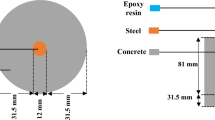Abstract
The pore structure of concrete has long been recognized as the key to a wide range of different mechanical, physical and chemical properties. However, the finite range of the different interrogation techniques for measuring pore structure has always limited our overall picture. In order to add to that picture, a high resolution, three-dimensional imaging technique called x-ray microtomography was employed as a way to link measurable microstructural features with alternate measurements of permeability in different concrete systems. Four different concretes were imaged at spatial resolutions between 1 and 4 microns. Using 3D image analysis techniques, the pore system was characterized by size distribution and connectivity. A parameter we termed “disconnected pore distance” correlated well with standard measures of chloride permeability.
Similar content being viewed by others
References
Roberts LR, Skalny JP (Eds.) (1989) Pore structure and permeability of cementitious materials. MRS Proceedings 137, (Materials Research Society).
Marchand J, Hooton RD, Thomas MDA, Beaudoin JJ (Eds.) (2001) Materials science of concrete: Ion and mass transport in cement-based materials. (American Ceramic Society).
Flannery BP, Deckman HW, Roberge WG, D'Amico KL (1987) Three-dimensional x-ray microtomography. Science, 237:1439–1444.
Auzerais FM, Dunsmuir J, Ferreol BB, Martys N, Olson J, Ramakrishnan TS, Rothman DH Schwartz LM (1996) Transport in sandstone: A study based on three dimensional microtomography. Geophysical Research Letters, 23(7):705–708.
Rintoul MD, Torquato S, Yeong C, Keane DT, Erramilli S, Jun YN, Dabbs DM, Aksay IA (1996) Structure and transport properties of a porous magnetic gel via x-ray microtomography. Physical Review E, 54(3):2663–2669.
Bentz DP, Quenard DA, Kunzel HM, Baruchel J, Peyrin F, Martys NS, Garboczi EJ (2000) Microstructure and transport properties of porous building materials: Three-dimensional x-ray tomographic studies. Materials and Structures, 33:147–153.
Landis EN, Nagy EN, Keane DT, Nagy G (1999) A technique to measure three-dimensional work-of-fracture of concrete in compression. Journal of Engineering Mechanics, 125(6):599–605.
Landis EN, Nagy EN, Keane DT (2003) Microstructure and fracture in three dimensions. Engineering Fracture Mechanics, 70(7):911–925.
Bentz DP, Martys NS, Stutzman PE, Levenson MS, Garboczi EJ, Dunsmuir J, Schwartz LM (1995) X-ray microtomography of an ASTM C109 mortar exposed to sulfate attack, Microstructure of cement-based systems/bonding and interfaces in cementitious materials. MRS Symposium Proceedings, 370:77–82.
Stock SR, Naik NK, Wilkinson AP, Kurtis KE (2002) X-ray microtomography (microCT) of the progression of sulfate attack of cement paste. Cement and Concrete Research, 32:1673–1675.
Bentz DP, Mizell S, Satterfield S, Devaney J, George W, Ketcham P, Graham J, Porterfield J, Quenard D A, Vallee F, Sallee H (2002) The Visible Cement Data Set. Journal of Research of the National Institute of Standards and Technology, 107(2):137–148.
Helfen L, Dehn F, Mikulik P, Baumbach T (2004) Synchrotron-radiation x-ray tomography: A method for the 3d verification of cement microstructure and its evolution during hydration, Nanotechnology in construction, Bartos PJM, Hughes JJ, Trtik P, Zhu W (Eds.) (Royal Society of Chemistry, Cambridge) pp. 89–100.
Gonzalez RC, Woods RE (2002) Digital image processing (Prentice Hall, Upper Saddle River, NJ).
Franklin WR (1999). Connect, http://www.ecse.rpi.edu/Homepages/wrf/research/connect/index.html.
AASHTO-T259 (1993) Resistance of concrete to chloride Ion penetration. American Association of State Highway Transportation Officials.
AASHTO-T277 (1993) Electrical indication of concrete's ability to resist chloride. American Association of State Highway Transportation Officials.
Feldman RF, Chan GW, Brousseau RJ, Tumidajski PJ (1994) Investigation of the Rapid Chloride Permeability Test. ACI Materials Journal, 91(2):246–255.
Detwiler RJ, Kjellson KO, Gjorv OE (1991) Resistance to chloride intrusion of concrete cured at different temperatures. ACI Materials Journal, 88(1):19–24.
Redmond M, Maine Department of Transportation, personal communication.
AASHTO-T126 (1993) Making and curing concrete test specimens in the laboratory, American Association of State Highway Transportation Officials.
Garboczi EJ, Bentz DP (2001) The effect of statistical fluctuation, finite size error, and digital resolution on the phase percolation and transport properties of the NIST cement hydration model. Cement and Concrete Research, 31:1501–1514.
Martys NS, Hagedorn JG (2002) Multiscale modeling of fluid transport in heterogeneous materials using discrete boltzmann methods. Materials and Structures, 35:650–659.
Author information
Authors and Affiliations
Rights and permissions
About this article
Cite this article
Lu, S., Landis, E.N. & Keane, D.T. X-ray microtomographic studies of pore structure and permeability in Portland cement concrete. Mater Struct 39, 611–620 (2006). https://doi.org/10.1617/s11527-006-9099-7
Received:
Accepted:
Published:
Issue Date:
DOI: https://doi.org/10.1617/s11527-006-9099-7




